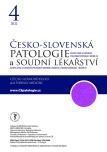New insights in the new WHO classification of adult renal tumors
Authors:
Ondřej Hes 1,2; Květoslava Michalová 1,2; Kristýna Pivovarčíková 1,2
Authors‘ workplace:
Šiklův ústav patologie, Lékařská fakulta Univerzity Karlovy v Plzni a Fakultní nemocnice Plzeň, Česká republika
1; Bioptická laboratoř s. r. o., Plzeň, Česká Republika
2
Published in:
Čes.-slov. Patol., 58, 2022, No. 4, p. 187-191
Category:
Reviews Article
Overview
The 5th edition of WHO classification of adult renal tumors introduced a couple of changes in existing, well established entities, as well as some new distinct renal tumors.
Papillary renal cell carcinoma (RCC) is no longer divided into type 1 and type 2. Type 1 is now called “classic” variant and type 2 doesn´t exist anymore. There were long discussion about problematic type 2. According to WHO 2022 the correct name is papillary RCC (and subtype/variant should be mentioned in the description). Another important change came for clear cell papillary RCC. Because there is no convincing evidence that genuine clear cell papillary RCC can produce recurrences or metastases, it is now termed as clear cell papillary tumor. All previously reported aggressive cases are now considered misclassified clear cell RCC (mostly) or other entities. In less typical cases, genetic support of diagnosis with complex analysis of VHL gene should be added.
New category “other oncocytic tumors” emerged for tumors from gray zone between renal oncocytoma and chromophobe RCC. Term hybrid oncocytic tumor should be reserved for those with hereditary Birth-Hogg-Dubé syndrome. Emerging entities, like eosinophilic vacuolated tumor (EVT) and oncocytic low-grade tumor (LOT) are mentioned, however, more work is needed for better establishment of the criteria.
There is a new category of “molecularly defined renal carcinomas”, where MITf translocation RCCs are divided into TFE3 rearranged RCC with fusion partner dependent morphologic variability, and to TFEB rearranged RCC. In this group, indolent TFEB translocated RCCs are recognized, as well as potentionally aggressive RCC with TFEB gene amplification. In WHO 2016, ALK rearranged RCC was considered as emerging entity. In WHO 2022 it is listed among “molecularly defined RCC” as a distinct renal tumor with broad morphologic spectrum dependent partly on fusion partners. ELOC (TCEB1) mutated RCC is renal tumor composed of clear cell elements and huge fibromyomatous stroma. Diagnostic approach should be complex with support of immunohistochemistry (including CK7) and molecular genetic approach. However, there is overlap with MTOR pathway genes mutated RCC with fibromyomatous stroma. SMARCB1 deficient renal medullary carcinoma is high-grade invasive adenocarcinoma in patients with clinically proved sickle-cell trait and SMARCB1 deficiency.
Keywords:
kidney – adult – renal tumors – WHO 2022 classification
Sources
1. Raspollini MR, Moch H, Tan PH, Amin MB, Turajlic S. Tumours of kidney. In: WHO Classification of Tumours Editorial Board. Urinary and male genital tumours. Lyon (France): International Agency for Research on Cancer; 2022. (WHO classification of tumours series, 5th ed.; vol. 8).
2. Williamson SR, Gill AJ, Argani P, Chen YB, Egevad L, Kristiansen G, et al. Report From the International Society of Urological Pathology (ISUP) Consultation Conference on Molecular Pathology of Urogenital Cancers: III: Molecular Pathology of Kidney Cancer. Am J Surg Pathol 2020; 44(7): e47-e65.
3. Trpkov K, Hes O, Williamson SR, Adeniran AJ, Agaimy A, Alaghehbandan R, et al. New developments in existing WHO entities and evolving molecular concepts: The Genitourinary Pathology Society (GUPS) update on renal neoplasia. Mod Pathol 2021; 34(7): 1392- 1424.
4. Trpkov K, Williamson SR, Gill AJ, Adeniran AJ, Agaimy A, Alaghehbandan R, et al. Novel, emerging and provisional renal entities: The Genitourinary Pathology Society (GUPS) update on renal neoplasia. Mod Pathol 2021; 34(6): 1167-1184.
5. Delahunt B, Eble JN. Papillary renal cell carcinoma: a clinicopathologic and immunohistochemical study of 105 tumors. Mod Pathol 1997; 10(6): 537-544.
6. He H, Trpkov K, Martinek P, Isikci OT, Maggi- Galuzzi C, Alaghehbandan R, et al. “High- grade oncocytic renal tumor”: morphologic, immunohistochemical, and molecular genetic study of 14 cases. Virchows Arch 2018; 473(6): 725-738.
7. Farcas M, Gatalica Z, Trpkov K, Swensen J, Zhou M, Alaghehbandan R, et al. Eosinophilic vacuolated tumor (EVT) of kidney demonstrates sporadic TSC/MTOR mutations: next-generation sequencing multi-institutional study of 19 cases. Mod Pathol 2022; 35(3): 344-351.
8. Trpkov K, Williamson SR, Gao Y, Martinek P, Cheng L, Sangoi AR, et al. Low-grade oncocytic tumour of kidney (CD117-negative, cytokeratin 7-positive): a distinct entity? Histopathology 2019; 75(2): 174-184.
9. Morini A, Drossart T, Timsit MO, Sibony M, Vasiliu V, Gimenez-Roqueplo AP, et al. Low-grade oncocytic renal tumor (LOT): mutations in mTOR pathway genes and low expression of FOXI1. Mod Pathol 2022; 35(3): 352-360.
10. Trpkov K, Hes O, Bonert M, Lopez JI, Bonsib SM, Nesi G, et al. Eosinophilic, Solid, and Cystic Renal Cell Carcinoma: Clinicopathologic Study of 16 Unique, Sporadic Neoplasms Occurring in Women. Am J Surg Pathol 2016; 40(1): 60-71.
11. Tretiakova MS. Chameleon TFE3-translocation RCC and How Gene Partners Can Change Morphology: Accurate Diagnosis Using Contemporary Modalities. Adv Anat Pathol 2022; 29(3): 131-140.
12. Argani P, Hawkins A, Griffin CA, Goldstein JD, Haas M, Beckwith JB, et al. A distinctive pediatric renal neoplasm characterized by epithelioid morphology, basement membrane production, focal HMB45 immunoreactivity, and t(6;11)(p21.1;q12) chromosome translocation. Am J Pathol 2001; 158(6): 2089- 2096.
13. Shah RB. Renal Cell Carcinoma With Fibromyomatous Stroma-The Whole Story. Adv Anat Pathol 2022; 29(3): 168-177.
14. Kuroda N, Trpkov K, Gao Y, Tretiakova M, Liu YJ, Ulamec M, et al. ALK rearranged renal cell carcinoma (ALK-RCC): a multi-institutional study of twelve cases with identification of novel partner genes CLIP1, KIF5B and KIAA1217. Mod Pathol 2020; 33(12): 2564- 2579.
Labels
Anatomical pathology Forensic medical examiner ToxicologyArticle was published in
Czecho-Slovak Pathology

2022 Issue 4
Most read in this issue
- New insights in the new WHO classification of adult renal tumors
- Key changes in WHO classification 2022 of testicular tumors
- Tumor lesions of penis and scrotum according to WHO classification 2022
- The changes and updates in the fifth edition of the WHO Classification of prostate tumors
